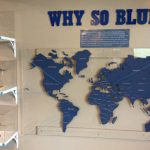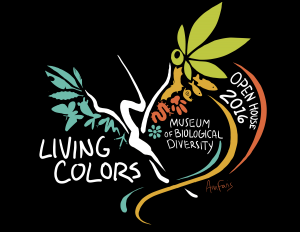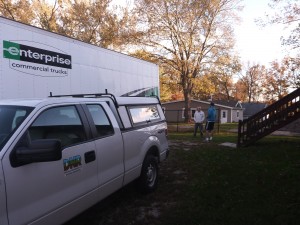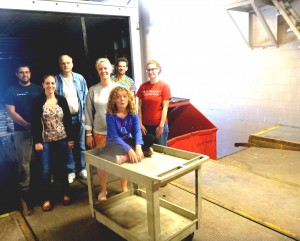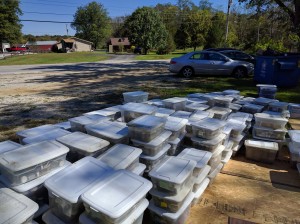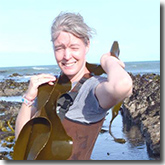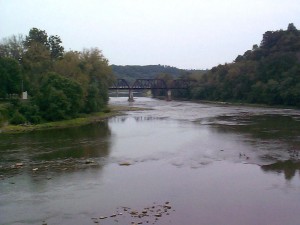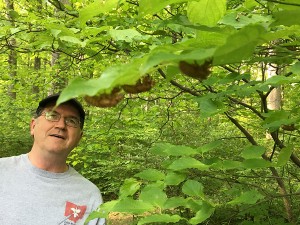
Grant Terrell proudly presenting a yellow-bellied marmot
We sat down with Grant Terrell, the Curatorial Assistant for the Tetrapod Collection, to learn more about him and his role within OSU’s Museum of Biological Diversity.
Hilary: “Are you a student at OSU?”
Grant: “Yes, this is my third year at OSU. When I first started my education here, I was an evolution and ecology major in the EEOB department, but I later added a history double major and a paleontology minor.”
Hilary: “What is your job at the Museum of Biological Diversity?”
Grant: “I’m currently the Curatorial Assistant for the Tetrapod Collection.”
Hilary: “How long have you been in this role?”
Grant: “I’ve been in this role for about 6 or 7 months now, so not too long, but I’ve been with the museum for three years. I actually had my first day of work before my first day of class at OSU! I reached out to the museum before I was a student, as I really wanted to work at the museum and it was a deciding factor in whether or not there was a place for me at Ohio State, as I was so fascinated with museum life and and I wanted to be a part of it. So, eventually I was hired as a Research Assistant, doing basic curatorial tasks, then moved onto Curatorial Assistant and am now the acting Collections Manager.”
Hilary: “What is a tetrapod?”
Grant: “The modern way to define it would be a group that contains mammals, amphibians, reptiles, and birds – their last common ancestor and then everything in between. So, dinosaurs are tetrapods, mammoths are tetrapods, and so on. Modern biology uses these types of definitions (they’re called clade-based definitions) for groups so as to avoid the arbitrary things that you can gain or lose in evolution – like legs.”
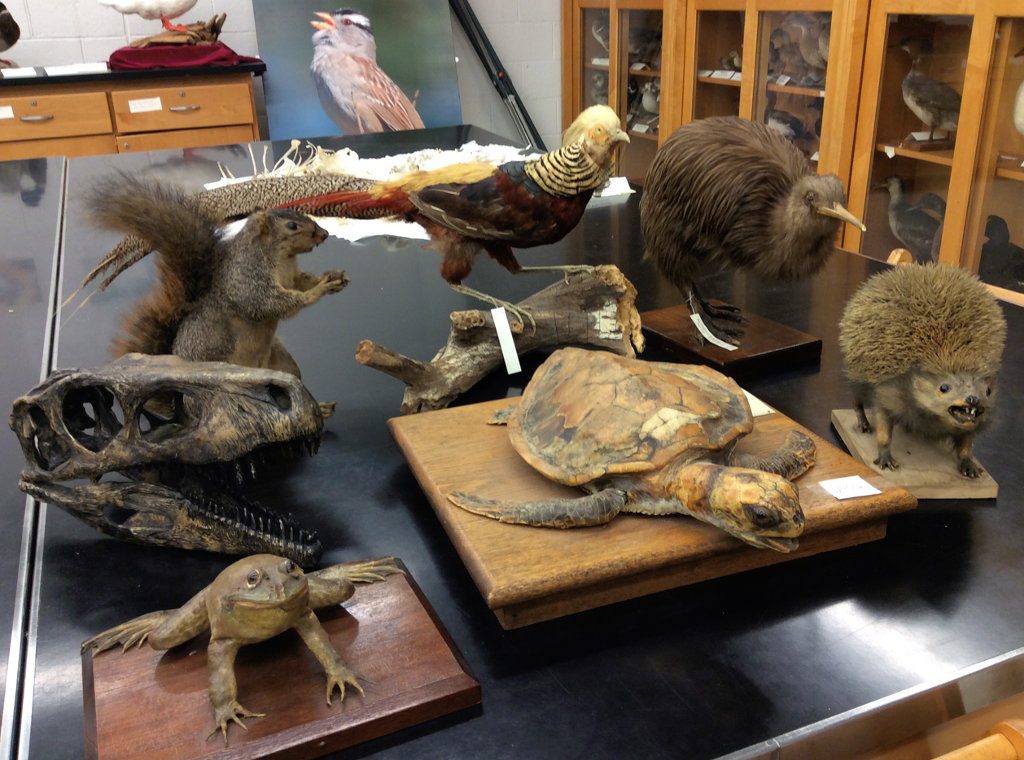
These are all tetrapods
Hilary: “Why is it important to study tetrapods?”
Grant: “The Earth is a system and it depends on the inner workings of many organismal groups. Tetrapods are only one component of this system, so I believe studying tetrapods is only as important as the study of any of these other groups. Still, it’s rather impossible for one person to comprehensively study all components of this system, and so we are forced to specialize.”
Hilary: “What is your favorite part about working in the Tetrapod Collection?”
Grant: “Being surrounded by diversity at all times of the day. For my spring break, I took a trip to Costa Rica (which is a biodiversity hotspot), but the diversity of animals in the tetrapod collection is at a magnitude much more dense than what I’ve ever experienced before, even in Costa Rica. And it is all right here in the museum – just drawers and drawers of specimens who have unique stories behind them.”

Grant Terrell with museum drawers of American Robins

Museum drawers with American Robins

Variety among American Robin specimens – note the albino in the middle
Hilary: “What is a discovery that you’ve made while working here?”
Grant: “When you start skinning and preparing the specimens, every mammal or bird, even something as common as a house sparrow – every single one is different. Not a single one is the same and when you’re with this specimen for hours preparing it, you start thinking about it’s life – about how it grew up, what it did throughout its day, what it was doing before it died – just with each individual one, you recognize that no one specimen is the same.”

Canada Goose recently prepared by Grant Terrell
Hilary: “You mention ‘skinning’ and ‘preparing’ specimens – can you elaborate on this? Is this something that you do on a day-to-day basis?”
Grant: “Typically, what I create are called study skins, which are different from taxidermy mounds. Taxidermy is more of an art form where you’re trying to depict an animal in a realistic lifelike pose, while study skins are to give you more of a general shape and visual idea of that particular individual, so you can look at things like molt patterns, color variations, differences in measurements – and they’re made to fit into a museum drawer. Preparing a specimen can sometimes feel like performing surgery, as some of the specimens that we receive have injuries, so you have to be careful with the work that you’re doing so as not to further damage the specimen.”
“Usually just about once a week at most I’ll do skinning because it’s so time consuming and once you’ve started on a skinning project, you can’t necessarily stop. But, if a specimen needs prepared, I prioritize by what I have time to do, what we have room for, and what would be valuable for the collection.”
Hilary: “Do you get these specimens as donations?”
Grant: “The majority of what we get is what we call “salvage” – specimens that are road kills or who have been victims of window strikes. In the past, people would kill the animals in the wild to add to the collection – those specimens are known as voucher specimens, which is essentially taking the species for educational purposes.”
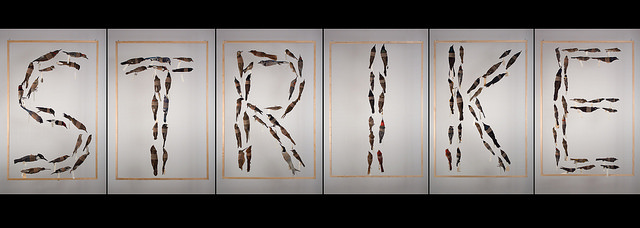
“STRIKE”-An art installation created to represent building fatalities in birds. ©Amy Youngs, 2015
Hilary: “What projects are being worked on now?”
Grant: “One of the biggest projects we’re working on now is to rebuild a relationship with the zoo to try to get future deceased specimens from them. The museum used to have a relationship with the zoo many years ago, but as the years went on there was a breakdown in the relations and we haven’t been getting regular specimens from them since the 70’s, so we’re currently working on building that relationship again. A lot of the animals at the zoo are critically endangered, so we want to preserve as many endangered specimens as we can for study, data collection, and genetic analysis for future generations.”

Barbets from the Columbus Zoo
“There’s also a lot of active research going on in the collections, and one of the big things that troubles us is space – we never have enough space and so we are working on acquiring more storage units – and we’re also undertaking projects to optimize space – such as pulling some of the older specimens that don’t necessarily have any data and trying to make room for the ones that do, so that we can add more to the collection.
I am also working on supervising weekly mammal preparations. I myself have only recently been trained in this- bird prep remains my forté – but I recently prepared a Douglas Squirrel and a Yellow-bellied Marmot, the first of its species in the collection. I plan to prepare a porcupine which we have in our freezer and I am expecting this to be quite the undertaking.”

Tree squirrels prepared by student volunteers
Hilary: “Is everything in the collection used for research?”
Grant: “Most of it. There’s also what we call a “teaching collection” – a lot of which is stuff that is older and outside of Ohio and it’s not as valuable for research, so we usually use it for teaching and outreach.”
Hilary: “What is the craziest thing you have found in the collection?”
Grant: “A dried sheep’s stomach inside of a manila envelope. It was just sitting in a random drawer and I was going through the collection one day, trying to catalogue items that hadn’t been catalogued and I opened up the envelope and there’s this sheep’s stomach. It didn’t have any information associated with it, except a tag that said “ovis,” which is the genus that sheep’s are in.”
“Another one is a raccoon specimen that we received, who had died after getting its head caught in a mason jar and the person who had prepared the specimen had left the rim of the jar around the neck of the specimen as a reminder to how the animal had died. I like that one because, to me, it symbolizes what I was saying earlier about every one of these individuals having a story and a life behind it. It reminds you not to take all of these specimens that we have here for granted.”

the inside of a sheep stomach with papillae

preserved four-chambered stomach of a sheep, a member of the ruminant family Bovidae

racoon specimen with head still stuck in glass jar
 About the Author: Hilary Hirtle is the Faculty Affairs Coordinator at the OSU Department of Family Medicine; her interest in natural history brings her to the museum to interview faculty and staff and use her creative writing skills to report about her experiences.
About the Author: Hilary Hirtle is the Faculty Affairs Coordinator at the OSU Department of Family Medicine; her interest in natural history brings her to the museum to interview faculty and staff and use her creative writing skills to report about her experiences.
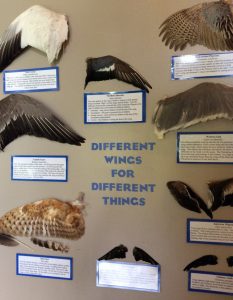
 The sound kiosk with various drumming patterns of woodpeckers and a snippet from BirdNote, a nonprofit radio program dedicated to the conservation of birds and their habitats, is tucked in the corner right next to the “window on nature” with great looks at various bird species visiting the numerous feeders. A Ruby-throated Hummingbird landed during my visit and drank leisurely from the provided sugar water solution.
The sound kiosk with various drumming patterns of woodpeckers and a snippet from BirdNote, a nonprofit radio program dedicated to the conservation of birds and their habitats, is tucked in the corner right next to the “window on nature” with great looks at various bird species visiting the numerous feeders. A Ruby-throated Hummingbird landed during my visit and drank leisurely from the provided sugar water solution. A poster gives basic information about the anatomy of flight and why some animals fly and we do not – at least not using our arms as wings, we built machines to take us into the air. To explore man-made flight visit the third of the exhibits at Gallant Farm.
A poster gives basic information about the anatomy of flight and why some animals fly and we do not – at least not using our arms as wings, we built machines to take us into the air. To explore man-made flight visit the third of the exhibits at Gallant Farm. About the Author: Angelika Nelson on her last assignment as the social media outreach manager for the Museum of Biological Diversity.
About the Author: Angelika Nelson on her last assignment as the social media outreach manager for the Museum of Biological Diversity.


